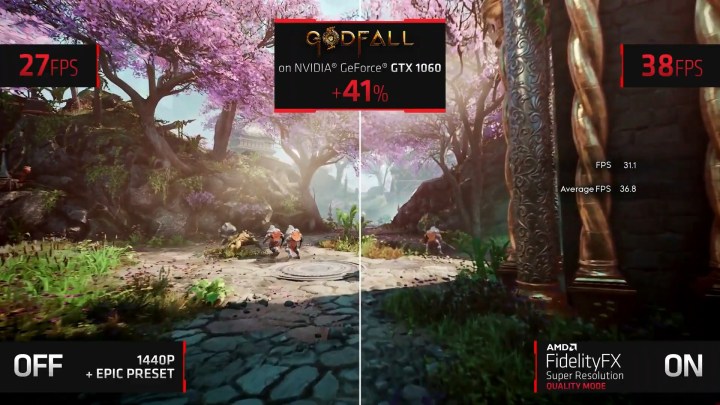During its Computex 2021 keynote, AMD launched its much-anticipated FidelityFX Super Resolution. This DLSS-like feature promises up to two and a half times the performance at 4K in games like Godfall, and it’s set to release on June 22.
Super Resolution is a new upscaling technique that functions similarly to Nvidia’s DLSS. AMD developed the feature around performance, image quality, and broad support.
It comes with four different performance modes: Ultra, Quality, Balanced, and Performance. Ultra gets as close to native image quality as possible, while the other modes slightly sacrifice image quality in favor of performance.
AMD showed off the capabilities in Godfall with an RX 6800 XT. Using the 4K Epic preset with ray tracing turned on, AMD measured an average of 49 frames per second (fps) at native resolution. Simply turning on Super Resolution to Ultra quality upped the frame rate to 78 fps — a 59% increase.

The more intense modes showed an even greater increase. The Performance mode brought the average frame rate up to 150 fps, surpassing even some of the best-performing DLSS titles.
Unlike DLSS, though, Super Resolution doesn’t require an AMD graphics card. AMD showed off the performance gains — a 41% increase in Godfall at 1440p with the Epic preset — with a GTX 1060.

AMD is launching Super Resolution with support for over 100 GPUs and CPUs, and AMD says it will support even more products over time. At launch, Super Resolution still comes with support for mobile GPUs and some APUs. At launch, FSR is available on RX 6000, RX 5000, RX 500, and GTX 10-series and newer GPUs, as well as all Ryzen CPUs with Radeon graphics.
AMD also doesn’t need to work directly with developers. Similar to the rest of the FidelityFX suite, developers are responsible for implementing Super Resolution in their games. Super Resolution uses less proprietary code, and developers have full ownership over that code and how it’s implemented in their games.
Wide adoption is still on developers, but AMD is hoping to support as many games as possible. AMD says that over 10 developers plan to use FSR in their games and game engines in 2021. The first batch of FSR titles should come later in June.
You can request games through AMD’s Super Resolution wish list.
The launch of Super Resolution puts a lot of heat on Nvidia. DLSS 2.0 is an effective tool for running demanding games with ray tracing, but Nvidia hasn’t been forthcoming about how developers can implement it in their games. DLSS doesn’t support AMD cards, either, forcing users to use Nvidia products.
If Super Resolution delivers the performance gains AMD promises, it could overwrite DLSS as the de facto super-sampling option. That’s no certainty, and we have to wait for further third-party testing to see how Super Resolution actually performs.




